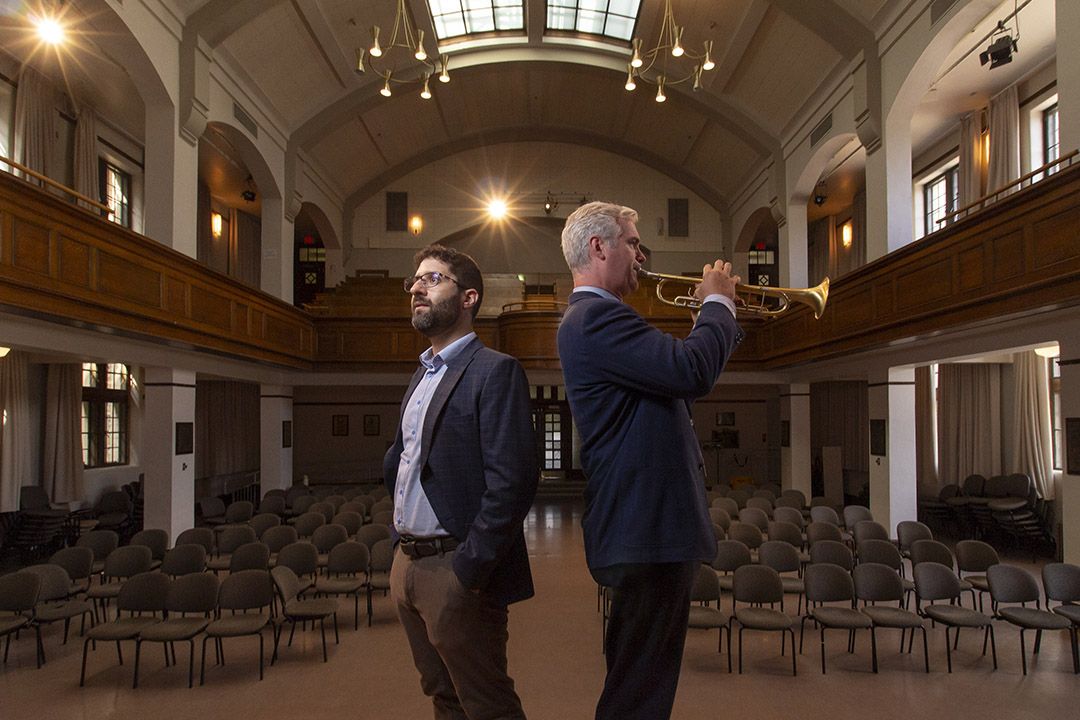
USask concert will mix music and math
Musical performance tells the story of University of Saskatchewan (USask) quantum science research.
By Chris PutnamAt a free concert at USask this month, audience members will be part of a bold experiment in conveying mathematical meaning through music.
On Wednesday, Sept. 20, the Saskatoon Jazz Orchestra and guest musicians will debut new music by Canadian composer Jeff Presslaff, based on the work of USask quantum science researcher Dr. Steven Rayan (PhD).
“I think that we’re going to treat people to the true interface of art and science, and I’m just really, really excited about that,” said Rayan, a professor in the Department of Mathematics and Statistics.
“Math + Jazz: Sounds from a Quantum Future” starts at 7:30 pm in Convocation Hall. Tickets are available for free through Eventbrite.
Composers have been finding musical ideas in mathematics for centuries, but the team behind this project has higher ambitions. The new compositions are not just inspired by math, said Rayan; they are a direct translation.
“We’re really trying to tell the story of the science, to explain the results, through this medium.”
Plans for the concert started in the College of Arts and Science more than two years ago during conversations between Rayan and Dean McNeill, head of the USask Department of Music and artistic director of the Saskatoon Jazz Orchestra.

“I’ve always been very impressed with Steven Rayan’s work and I have an amateur’s interest in mathematics,” said McNeill. “The more I was talking to him, the more I thought there is an opportunity here to use the Saskatoon Jazz Orchestra to help tell an interesting story in an interesting way.”
McNeill connected Rayan with Presslaff, a Montreal-based composer known for his intellectual and exploratory approach to music. Rayan and Presslaff began to collaborate on a set of five compositions that would carry listeners through the five sections of a 2021 research paper titled “Hyperbolic band theory.”
Written by Rayan and University of Alberta physicist Dr. Joseph Maciejko (PhD), the influential paper described a new theory of quantum material based on hyperbolic geometry. The research—which Rayan will speak about at the upcoming concert—could lead to the creation of new materials with warped crystal structures that would have exciting technological applications.
“The first problem was understanding what Steve is talking about!” said Presslaff. “Fortunately, he’s a great, patient teacher. We spent many Zoom hours getting into his ideas and talking about possible musical analogies.”
Presslaff was so strict in his pursuit of authenticity that he spent a year and half independently studying linear algebra, topology, and group theory to understand Rayan’s work.
“He was not willing for the work to be some loose interpretation. He didn’t want any wiggle room with the truth. The music had to be exactly representative of the science and the mathematics,” Rayan said.
Rayan believes Presslaff succeeded.
“When Jeff started sharing music with me, I … really felt like I could hear the physical structures in it. I could hear the warped crystals. I was experiencing the rules of physics that break when you go from ordinary materials to these hyperbolic materials. And this was absolutely fascinating to me. I really felt like I was hearing the paper.”
Presslaff said audiences will recognize his new compositions as jazz, but there are elements of classical music, with a tone that ranges from lively to contemplative.
The band for the concert—aptly named the Hyperbolic Band—consists of the Saskatoon Jazz Orchestra with guest musicians on string and orchestral instruments. Most of the guest artists are USask music department alumni, students, and faculty.
The true test of the project’s success will be what audiences take from the Sept. 20 performance, said Rayan. The mathematician, who has collaborated with artists in the past to create visual translations of his research, believes music could be a new frontier in communicating science.
“I want to explore alternative ways of presenting the science to the people who it will matter to in the end, which is not just the people in labs, but everyone,” he said. “If there’s one thing that I want people to take away from this, it’s that science can also be fun. Science is not dry. It has a rhythm to it, and I want people to hear that rhythm.”
Together we will support and inspire students to succeed. We invite you to join by supporting current and future students' needs at USask.

